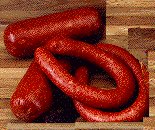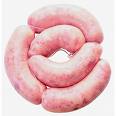Sausage Meat
From the beginning, sausage meat was chosen based on what was available and abundant.
Sausage recipes were developed that took advantage of what people had.
If pigs were common ( as they were in so many areas), people made pork sausage. If families lived on sheep, guess what went into their sausage?
Some cultures had dietary restrictions based on religious beliefs...
...I doubt you would find many traditional Muslim or Jewish pork sausage recipes.
Pork
-
For a lot of people, when you say sausage...they think pork.
There was a time when most families had a pig or two fattening...and many of them found their way into sausage meat and the recipes that we still use.
Just about any part of the pig can be (and often is) ground for sausage meat. As home sausage makers, we can be a bit more selective about what cuts we use.
I've often wondered why "whole hog breakfast sausage" became something to brag about on a label...there are plenty of parts on a hog I'd just as soon not eat.
If, like me, you rely on the butcher or meat market for your meat, You probably want to stick with pork butt for your sausage making.
Pork butt is a cut from the shoulder of the hog, and you may find it marketed as pork shoulder. It is economical to use and already has about the correct ratio of meat to fat (15 to 20 percent).
Sometimes you can find really good deals on other cuts.
My local supermarket often runs a special on "country style boneless pork ribs". This cut comes from the shoulder section (like the Boston butt does) and makes good sausage as long as it has enough fat content.
You do need to use fat in your sausage making. I find that if I use much less than 15 to 20 percent fat, my sausage turns out dry and the taste suffers.

You can use any of the leaner cuts of pork for sausage meat when you find an especially good deal, just make sure you add enough extra fat to get to that 15 to 20 percent ratio.
TIP
- When I know I am going to need a large quantity of pork butt for sausage making, I'll tell my meat man well in advance. He may have to order the meat for me.
Several times he has even given me a better price because I took delivery in bulk. When you break down the shoulder and do the boning yourself, you'll save him money on time and labor...
...It's worth asking.
Beef
-
There isn't any one special cut of beef that I find best for sausage making.
The important thing to keep in mind is that the more tender cuts tend to be the most expensive. There's just no reason to break the bank and use costly steaks and roasts when a cheaper and tougher selection will work just as well.
That's the approach that most butchers take when they grind hamburger so...I often use already ground hamburger for my beef sausage (especially when it's on sale).
By law in the U.S., hamburger must be labeled with it's maximum fat content, and I like to use the 15 percent ground beef in my sausage.
Depending on the meat texture that your recipe calls for, you may not even have to grind the hamburger again. Just add the spices and seasonings and go from there.
Tip
-
Several time a year, one of the markets in my area will advertise ground beef as a loss-leader (below cost) to lure in customers.
That's when I'll buy a large quantity and freeze it for future sausage meat.
If it's packaged correctly, ground beef will keep nicely in the freezer for up to 4 months (I've even kept it longer).
Lamb
-
In my neck of the woods, lamb tends to be fairly pricey. Because of that, lamb sausage is a special treat for us.
Like with beef, it isn't necessary (or even very smart) to use the best cuts of the lamb for lamb sausage meat. Stay with cuts from the shoulder, neck, or breast.

Depending on the specific cut of lamb you use, the meat may be too lean for good results.
If you can get lamb fat from your meat person, add it to reach the same 15 to 20 percent ratio we used for pork and beef.
If you can't find extra lamb fat, you'll have to substitute. I use beef fat when I need to do that.
Tip
-
If you can find one in your area, use a butcher or meat market instead of relying on the supermarket meat counter. They're used to requests from customers and more likely have (or can get) what you need.
Wherever you buy your meat, get to know the people behind the counter. They'll try their best to help, and if they don't or can't, move on to somewhere else.
I'm known at my market as "that guy with the beard who always wears the hat and likes to make sausage".
Poultry
-
You can make very high quality sausage by using chicken and turkey as your sausage meat. You just need to remember to use both the white and dark meat and to include some or all of the skin when you grind it.
If you don't add the skin, you'll have to find a substitute to add as a binder or the sausage will be very dry and crumbly.
It's usually most economical to buy whole birds and bone them yourself.
There are times that you can find very good deals on packaged portions like thighs and boneless breasts though. Don't be afraid to take advantage of bargain prices. Package and freeze your market windfalls for future use.
Tip
-
I have found turkey as low as 39 cents a pound during the week just before Thanksgiving (another loss-leader). If you have the freezer space, that's the best time of the year to stock up for sausage making.
Game
-
Any kind of game can be used for sausage...anything from large critters like deer and elk down to rabbits and squirrels. I've even had sausage made from alligator, and it was great!
When you use game for sausage you'll be doing most or all of the meat processing yourself.
Bone the meat carefully and be sure to discard any areas that are damaged or off-colored. Then, treat your meat like its closest domestic counterpart.
Just remember...If you wouldn't normally want to eat it, don't grind it into sausage.
You'll find that game tends to be much leaner than other meat. I've always needed to add either pork or beef fat (or a combination) to get the results I want. Use the same old 15 to 20 percent ratio.
I had very good luck one year by mixing my venison with ground pork instead of just the fat.
No matter what you decide to use for sausage meat, don't be afraid to experiment with recipes. Some of the best sausage I have ever made was a result of substituting elk for pork in a smoked Polish sausage recipe. I just made sure to add a little extra...you've got it...fat.